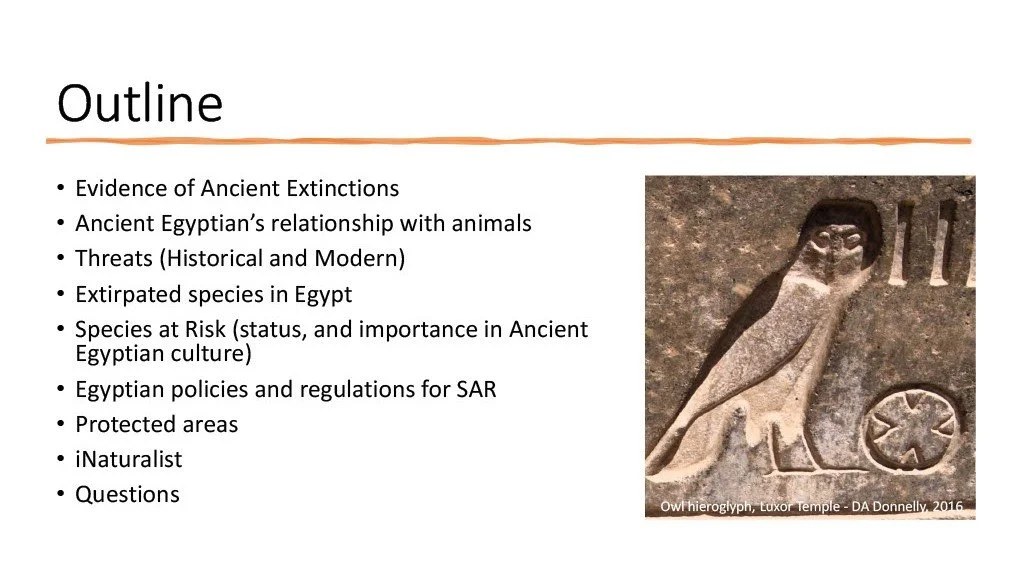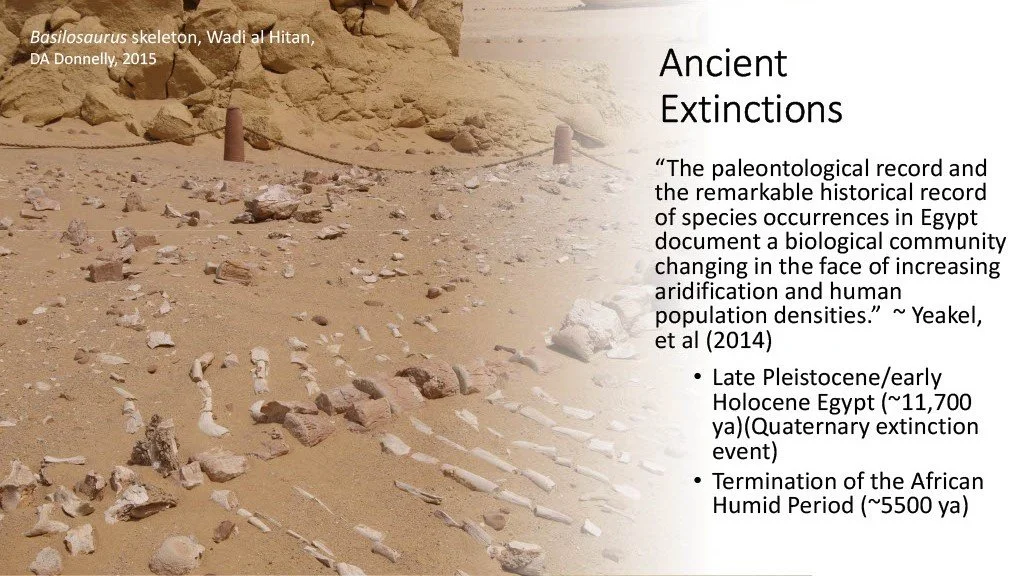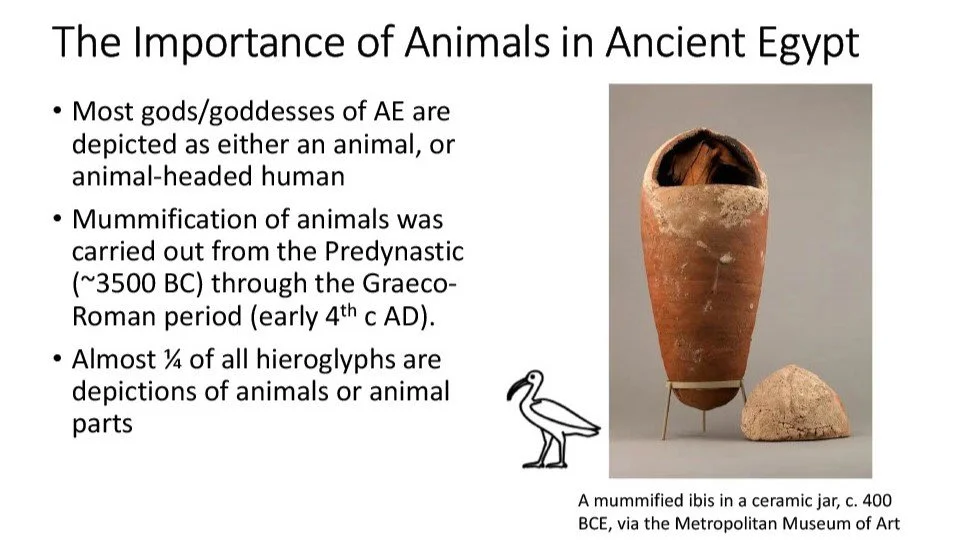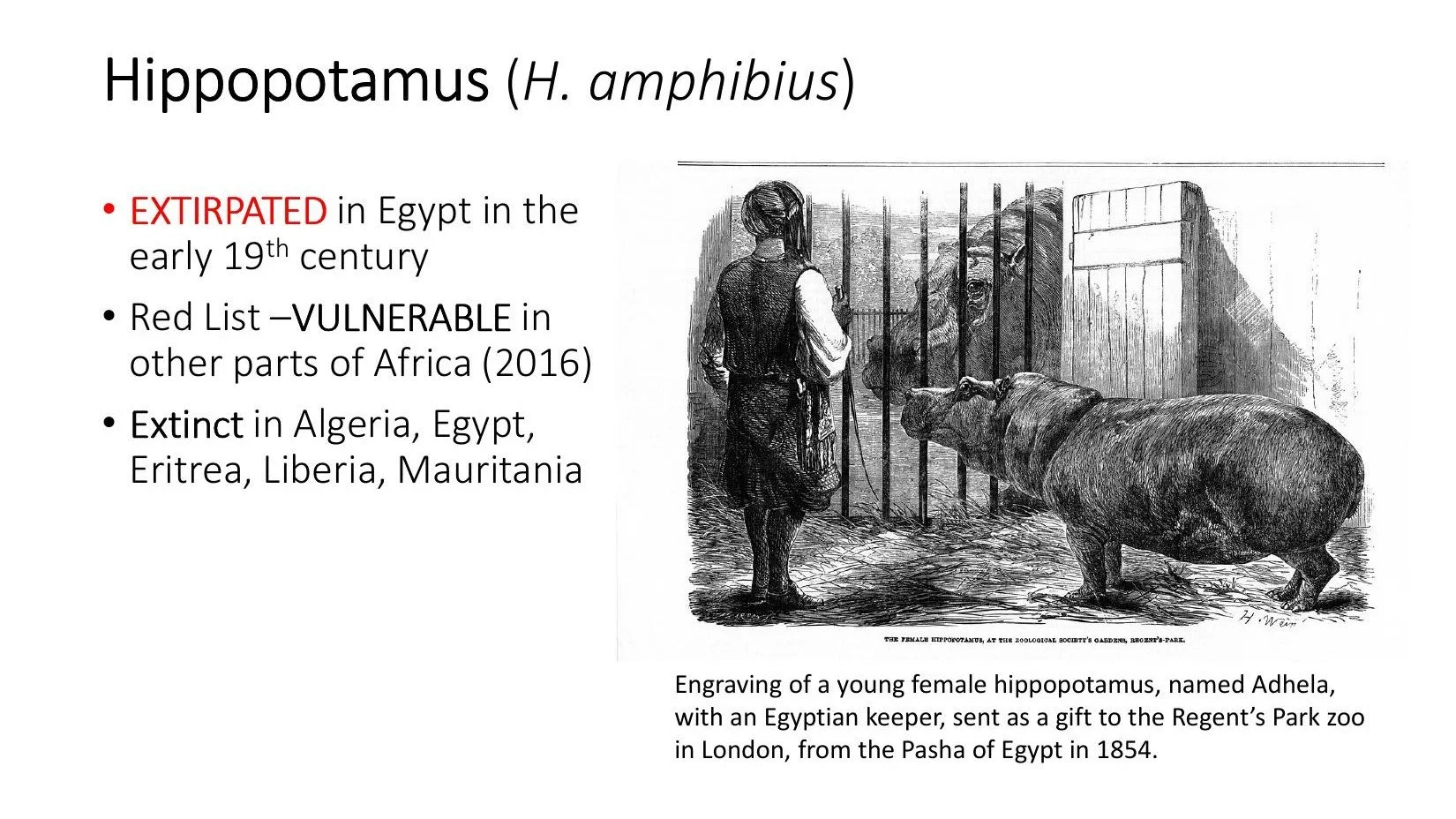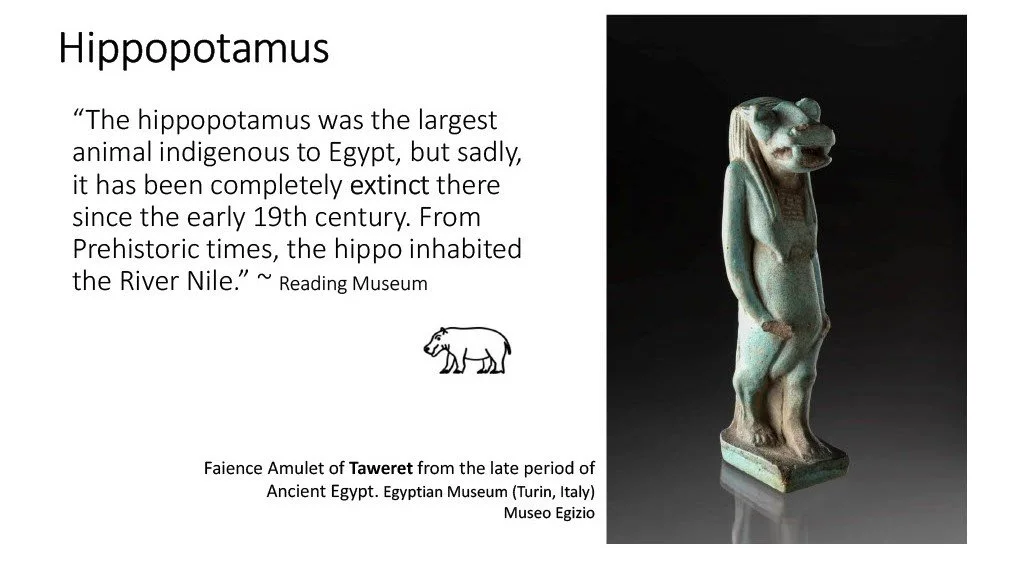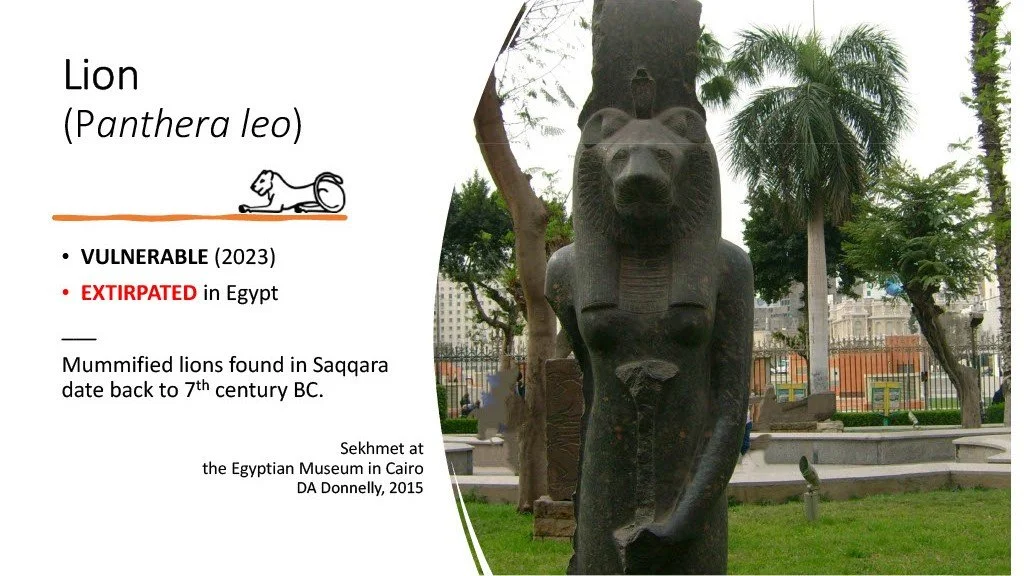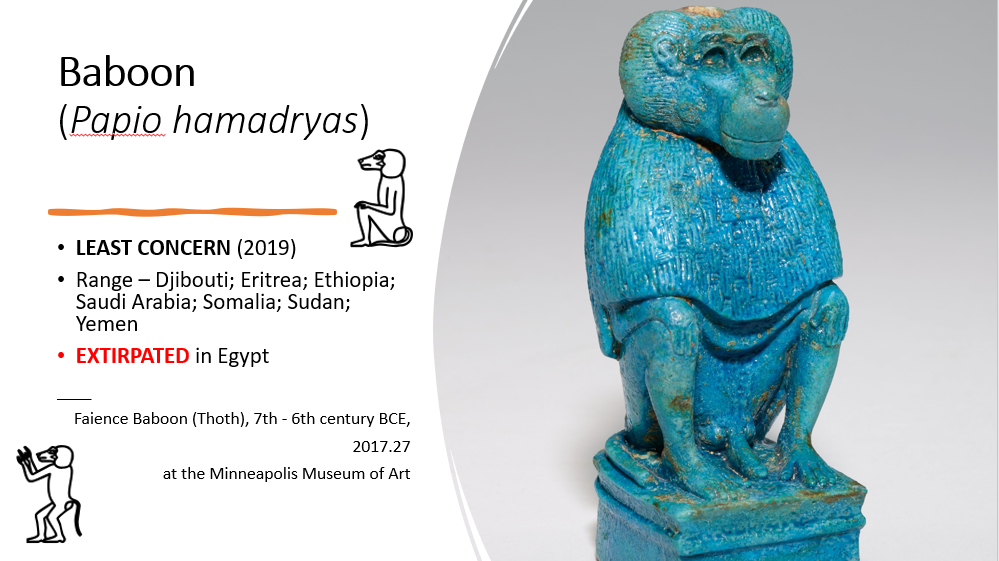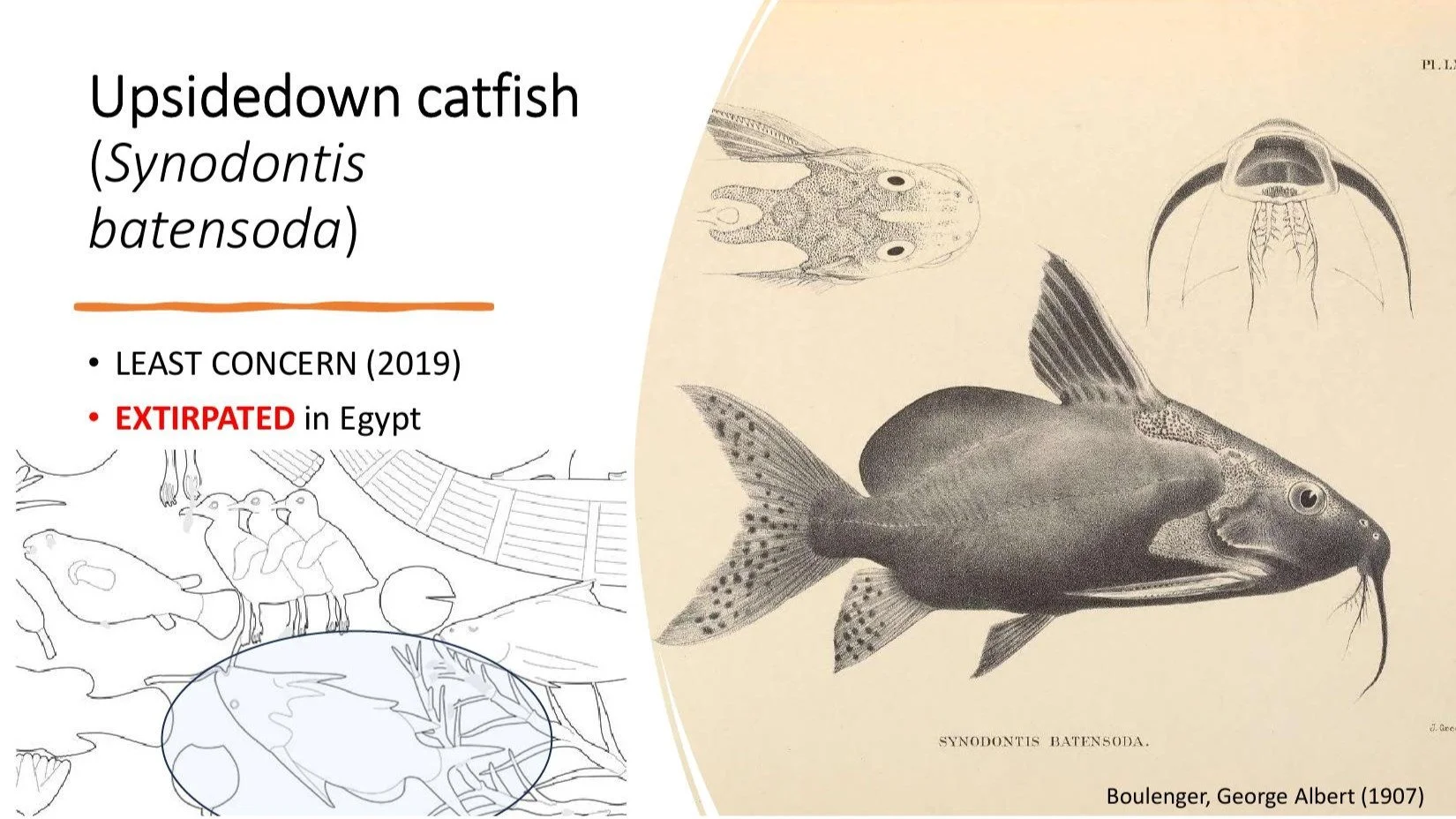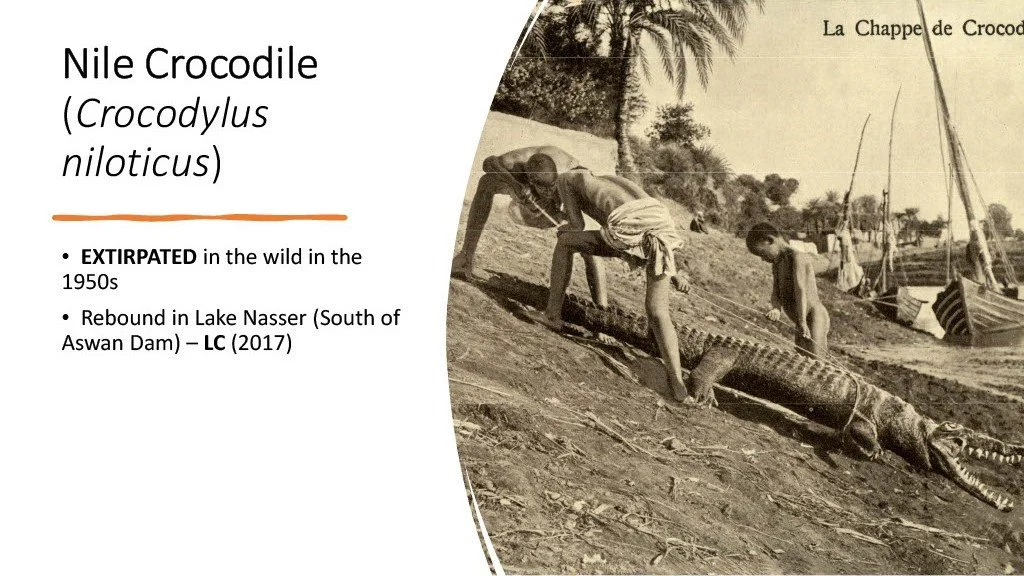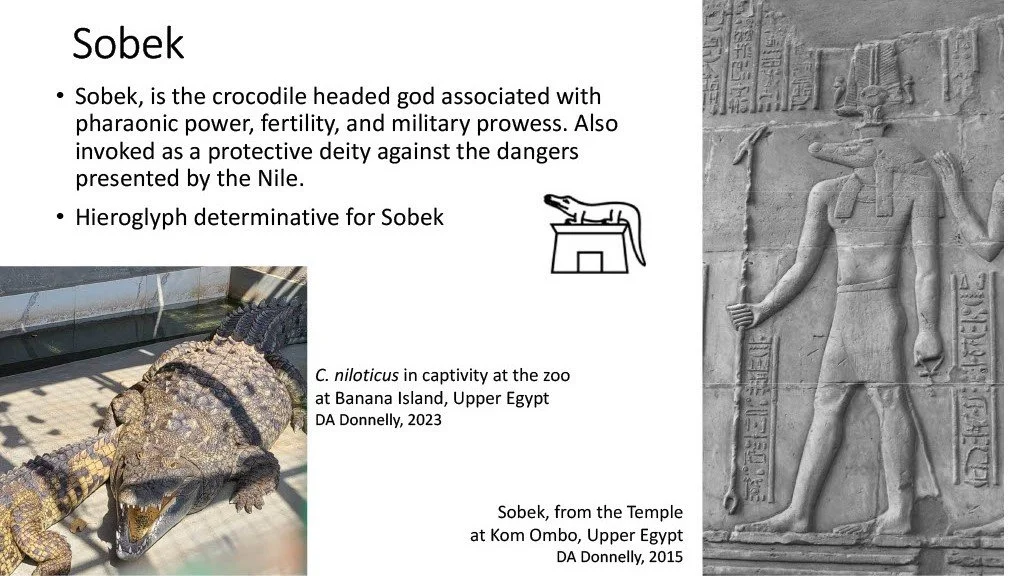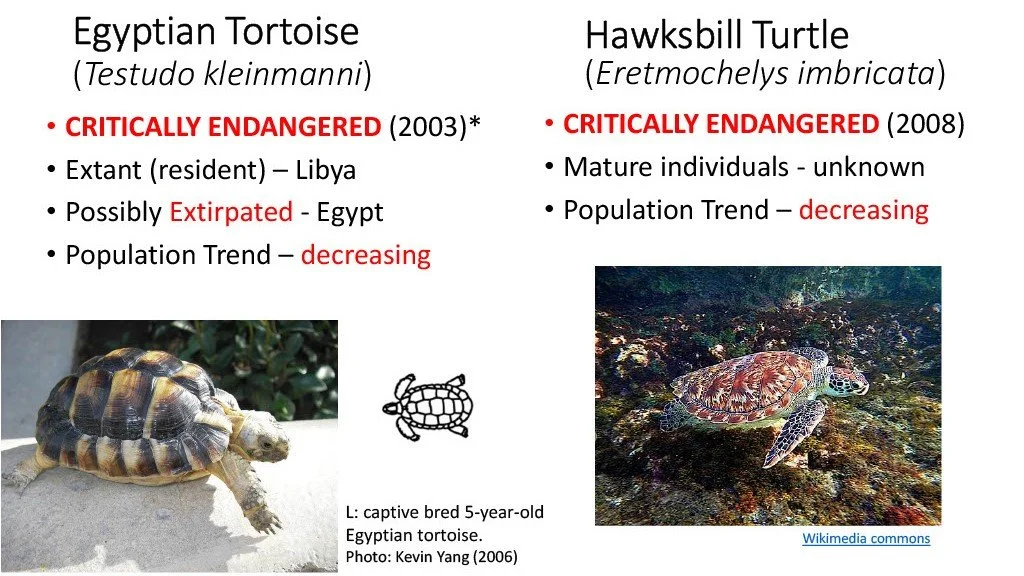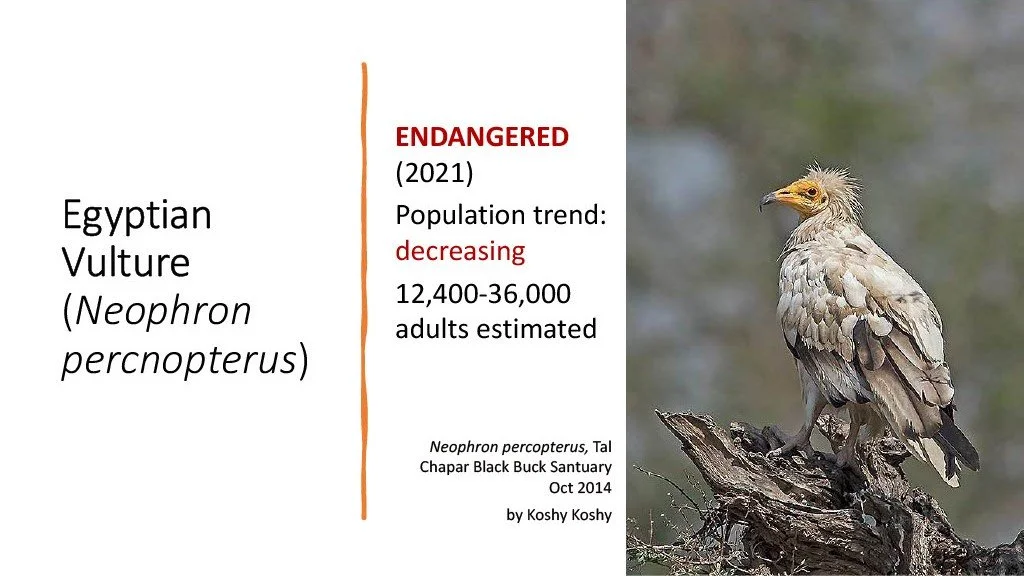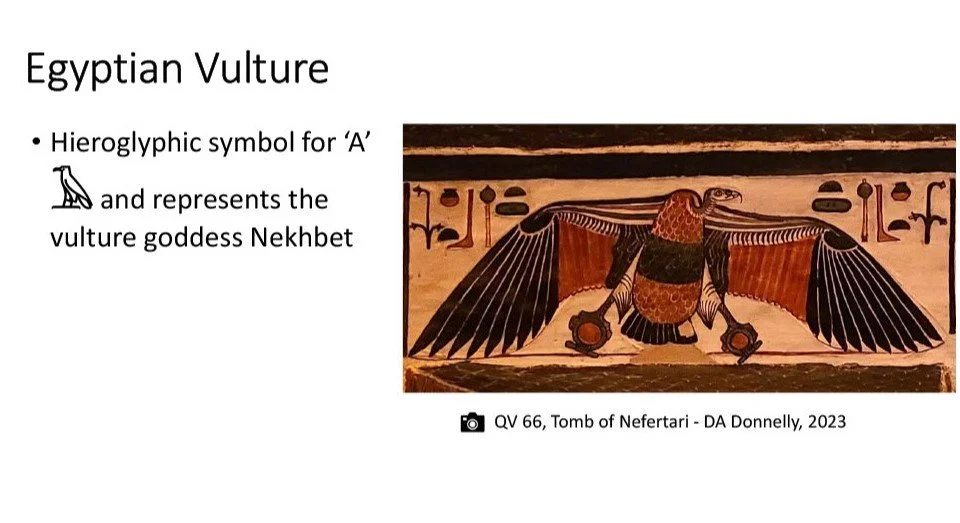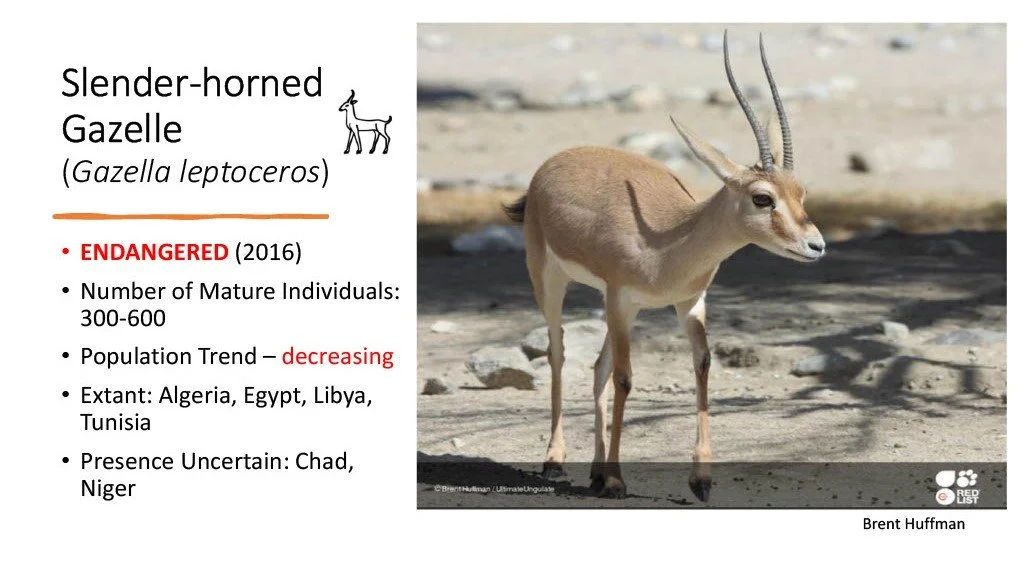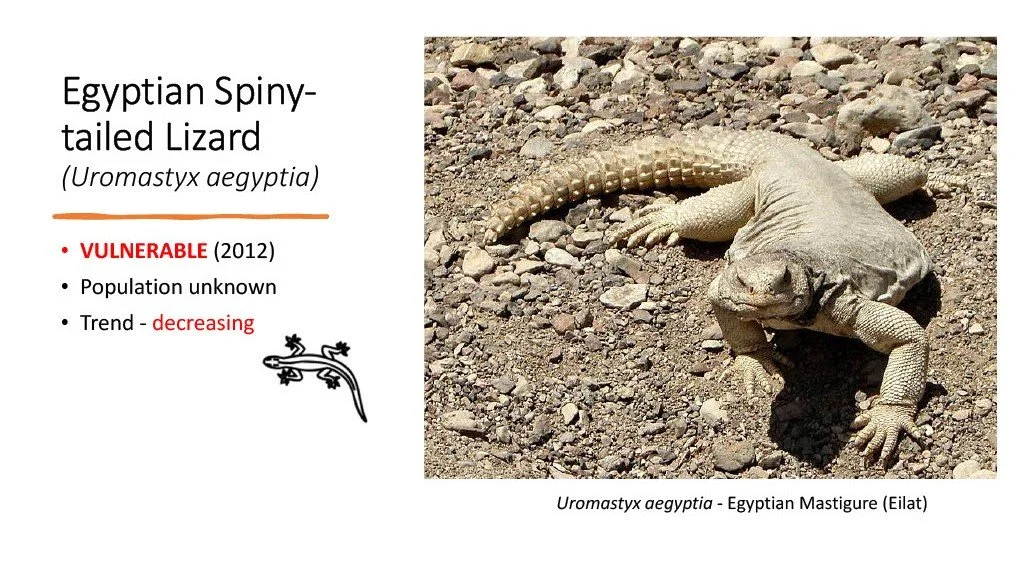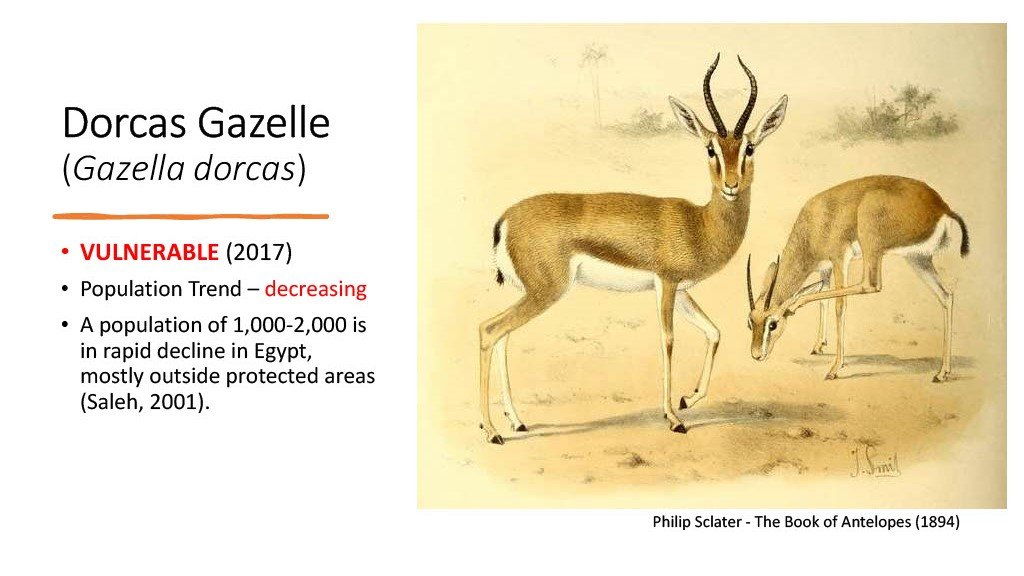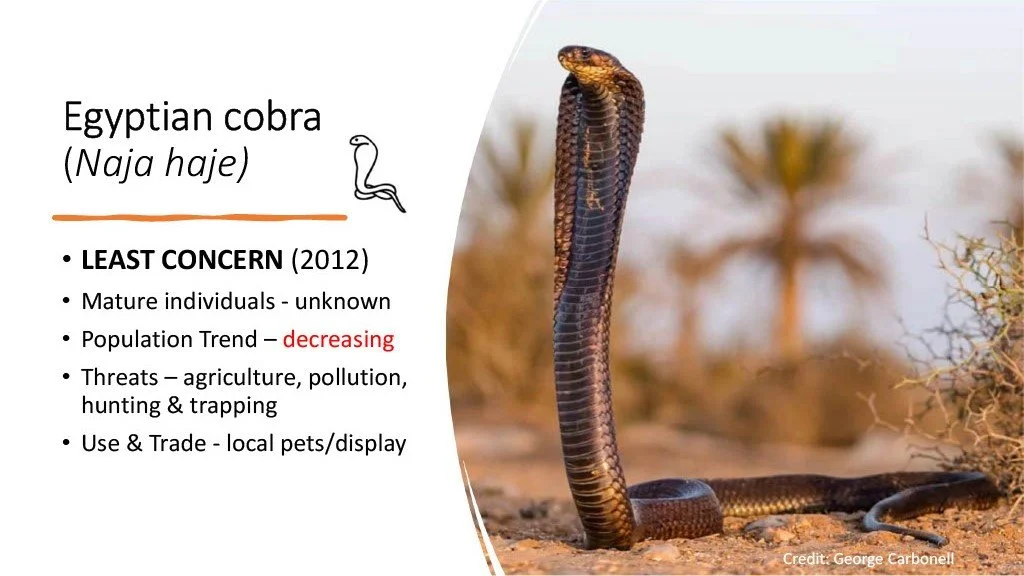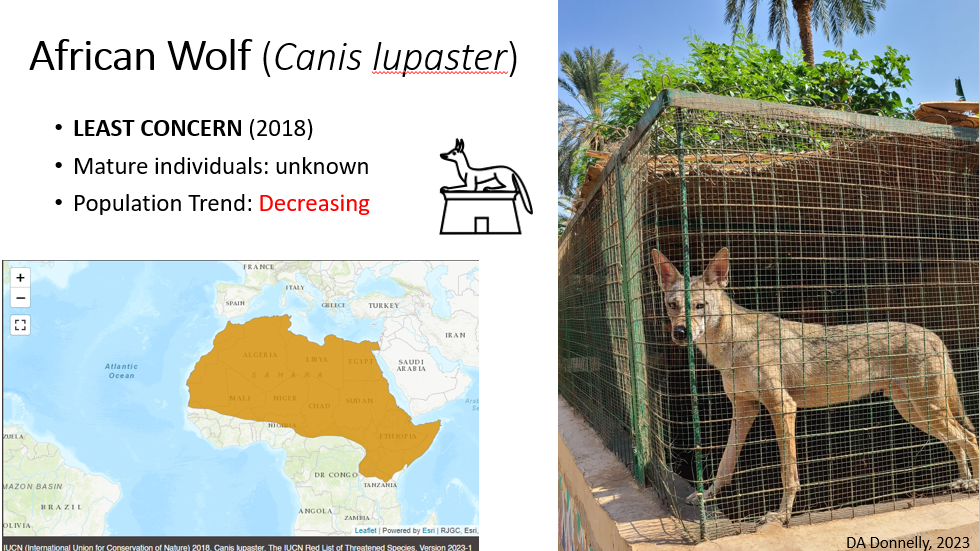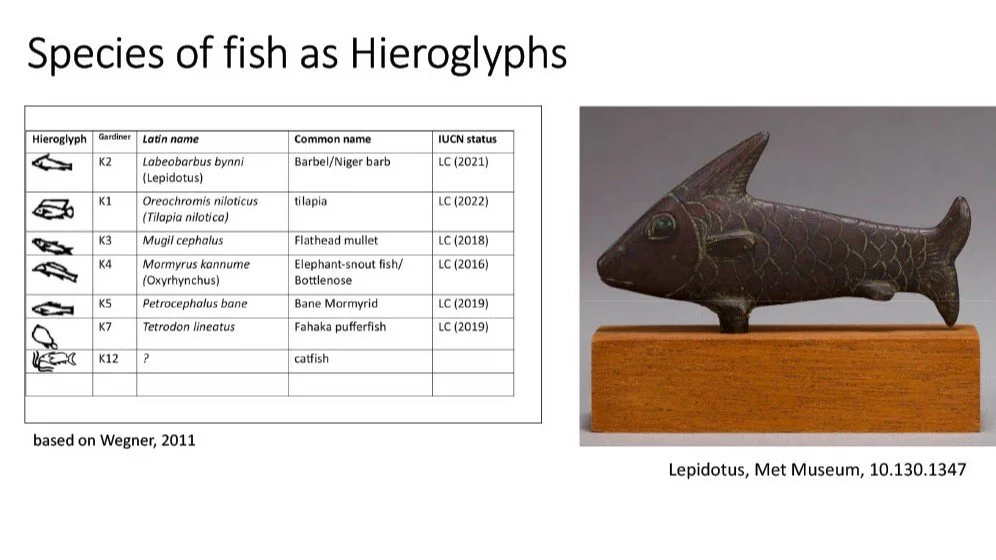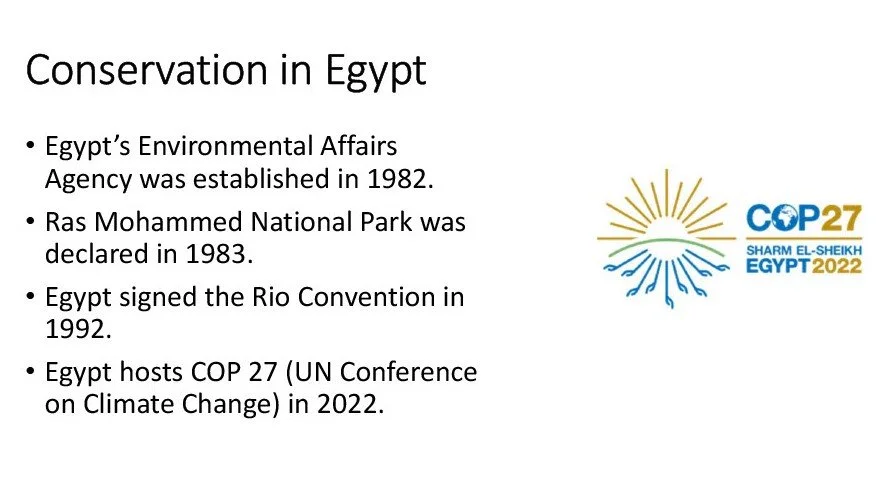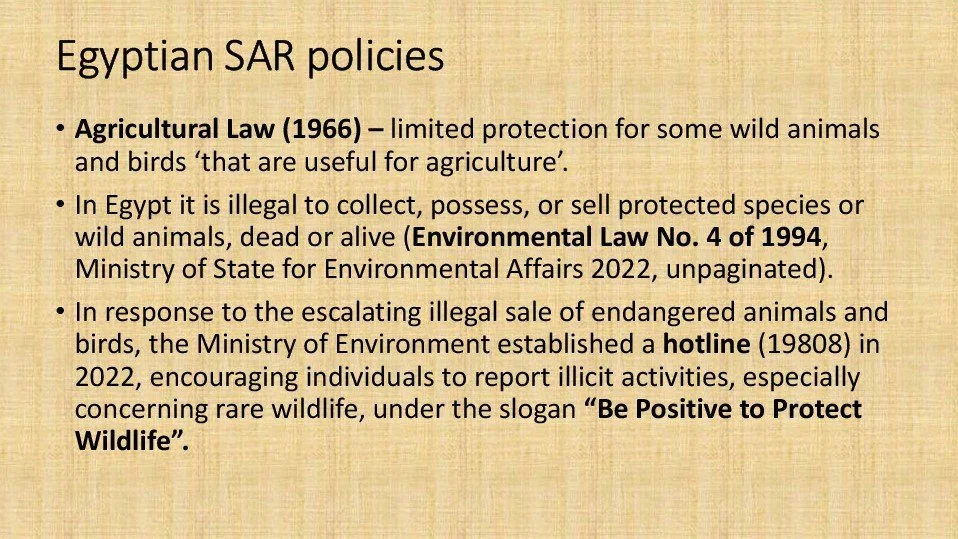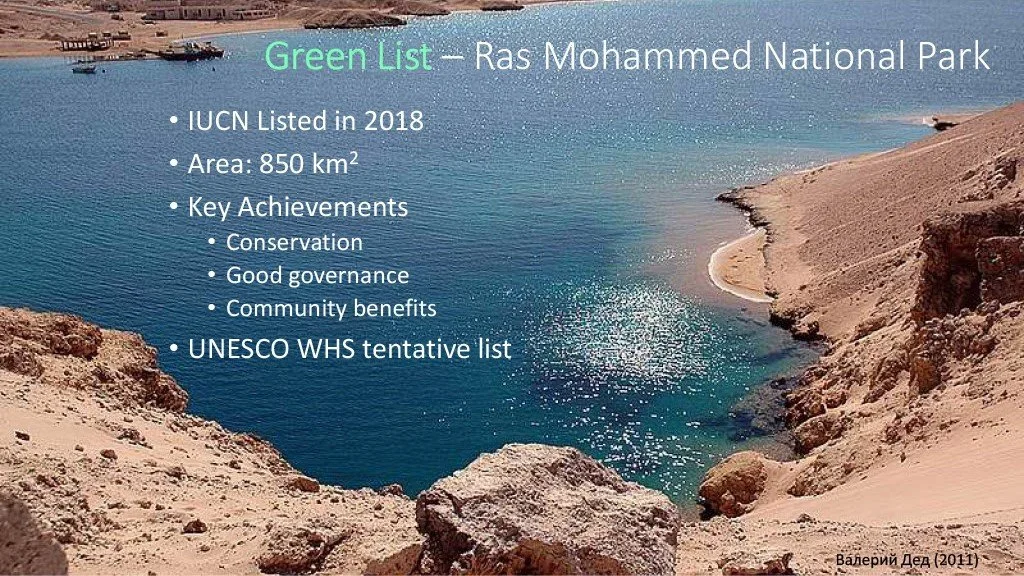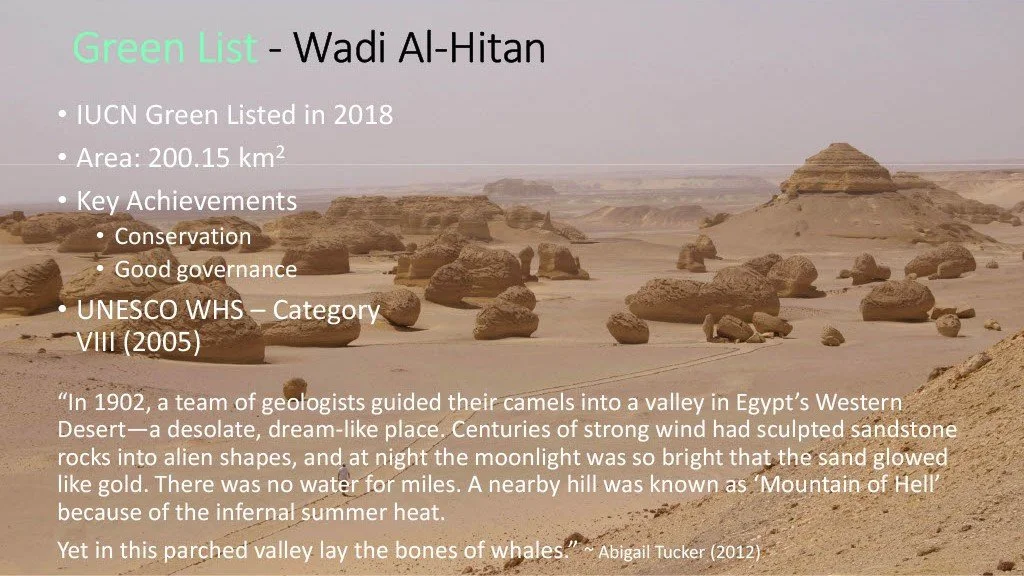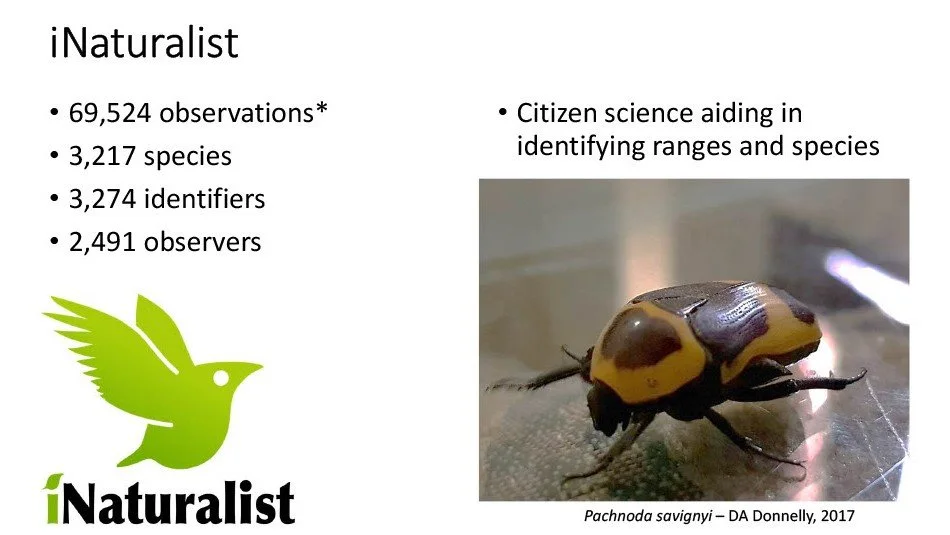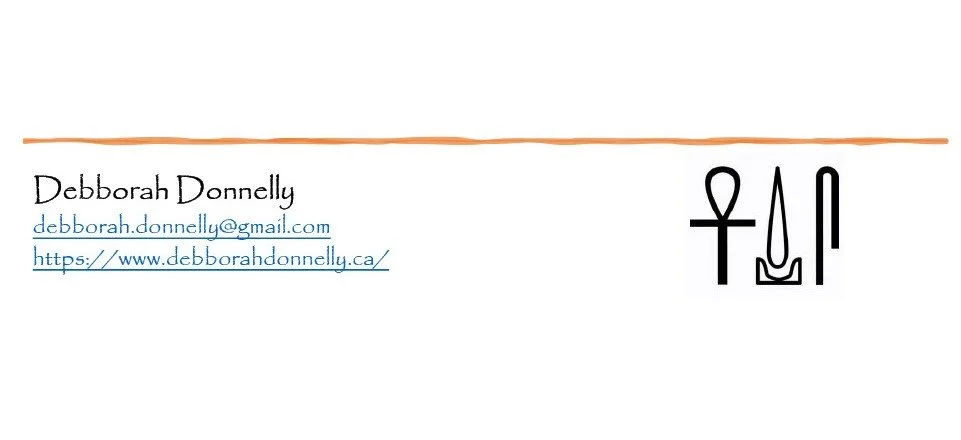A History of Egyptian Species at Risk
Cover Photo: Faience hippopotamus, Egypt, MK to 2nd IP, Brooklyn Museum
My name is Debborah Donnelly, I have a BSc and MA in archaeological sciences and Egyptian archaeology. I also have post-graduate diplomas in Climate Change Science and World Heritage Conservation (natural and cultural).
This presentation is based on a marriage of archaeology and conservation. Due to my inability to read complex, technical Arabic, the information herein was taken primarily from English and/or French references (from Herodotus in the 5th c BC to 2024 CE). It is not a comprehensive discussion of all species at risk (SAR), but an overview of select, historically important species.
Following are the slides and speaking notes. A pdf of the slides and a list of references is available upon request.
Egypt has left a rich paleontological, archaeological and historical record that allows us to track the changing ecological footprint over time.
Combination Theory suggests that climate change (from the last glaciation) and human arrival and overhunting worked in tandem to cause the Quaternary Megafauna Extinction Event. There was a reduction of large mammals (>4 kg) in Egypt at this time. (Yeakel, et al, 2014)
Around the termination of the African Humid Period (around 5500 y BP) there was a second disappearance of species like spotted hyenas, warthogs, zebra, wildebeest, and water buffalo. (Yeakel, et al, 2014)
During the last 150 years there was another extinction wave (with the arrival of efficient firearms). This more recent occurrence resulted in a disproportionally fast extinction rate of most prey and predator species (>10 kg). The 19th–20th century extinction was the most fatal for the majority of wild mammalian taxa. (Bar-Oz, et al, 2015)
Taxa that escaped extinction and survived to this date include opportunistic ungulate (e.g., gazelle and ibex) and carnivore (fox, golden jackal, and hyena), species that are less sensitive to environmental changes, some of which inhabit the desert, a less populated habitat. (Bar-Oz, et al, 2015)
Egyptians had a close relationship with animals. Foreign ancient references include:
· Herodotus (5th c BC) Histories, who describes in some detail about Egyptian attitudes towards animals.
· Diodorus Siculus (60-30 BC) Bibliotheca Historica, also mentions the reverence of Egyptians for cats and the punishment of death for killing one.
“the practice of en masse burials of ibises at Tuna el-Gebel lasted almost 700 years. Though it is impossible to give the exact number of birds buried at Tuna el-Gebel, also because in many bundles or mummies we only find parts of birds, the total number of ibises deposited in the vast subterranean network of galleries clearly surpasses one million individuals, implying that on average some 15,000 birds had been placed each year…” (von den Driesch, et al, 2005)
Unfortunately the Sacred Ibis (Threskiornis aethiopicus) is now extinct in Egypt. Last assessed for the IUCN Red List in 2018, listed as LC in other parts of Africa.
Mummification was carried out for a variety of reasons, including sacred (representations of the gods/goddesses), votive offerings to the deceased, and to preserve their pets and food for the afterlife. Some of the species that have been mummified include:
Baboons, bulls, cats, crocodiles, dogs, ducks, fish, gazelles, geese, hawks, ibis, lions, lizards, monkeys, owls, rams, scarabs, shrews and snakes…
Threats
Aswan Low Dam – was built in 1898-1902, but did not impede the annual flooding of the Nile, which brought nutrients and minerals to the floodplains.
Aswan High Dam – built in 1960-1970 – creating the massive Lake Nasser south of it, and required the displacement of many people and some cultural structures (e.g. Abu Simbel) with the intent to reduce floods and droughts, and provide electricity. It also eliminated the nutrients and ecology of the riparian area of the Nile River (loss of habitat).
Overhunting will be discussed in relation to the Nile Crocodile (below).
Population
Canada’s population in 2023 is 40.5 million people; we have an area of 9.985 million km2
Egypt’s population in 2023 reached 106 million people, and they have an area of 1 million km2. Their population is increasing by about 1 million people per year. https://www.worldometers.info/world-population/egypt-population/ '
For comparison, Canada has less than half the population and almost 10x the area of Egypt.
Tourism - in 1952 Egypt accommodated around 100,000 tourists, by 2010 there were 14 million tourists. The revolution in 2011 reduced visits by 37%, but by 2019 they were almost back up to 2010 levels, and then with COVID in 2020 the number of people going to Egypt fell to 3.5 million. https://en.wikipedia.org/wiki/Tourism_in_Egypt
In 2023 Egypt breaks record with 14.9 million tourists (Ahram online, 17 Jan 2024). The issue with so many tourists is that they want air-conditioned hotels and vehicles, special diets, and create massive amounts of garbage and GHGs.
Increased Pollution – due to increased population and tourism, with limited infrastructure to deal with waste.
Extirpated Species
Hippopotamus – currently listed on the IUCN Red List as VULNERABLE (last assessed in 2016); but was extirpated in Egypt in the early 19th century.
The hippo was the representation of the goddess Tawaret - protective goddess of childbirth and fertility.
Male hippos were thought to be manifestations of chaos; consequently, they were overcome in royal hunting campaigns, intended to demonstrate the divine power of the king. (Verner, 1969)
Female hippopotamuses were revered as manifestations of apotropaic deities, as they studiously protect their young from harm. Protective amulets bearing the likenesses of female hippopotamuses have been found dating as far back as the Predynastic period (c. 3000–2686 BCE). (Germond & Livet, 2001)
Lion – IUCN Red List as VULNERABLE (last assessed in 2023); extirpated in Egypt.
Population of mature individuals: 23,000 (decreasing)
Mummified lions found in Saqqara date back to 7th century BC. Gods that were represented by lions include:
Sekhmet whose name means: “She who is powerful” or “the One who loves Ma’at” was the goddess of the hot desert sun, plague, chaos, war, and healing. https://egyptianmuseum.org/deities-sekhmet
Bast/Bastet – originally a lioness, but later depicted as a housecat – the goddess of protection, pleasure, and the bringer of good health
Maahes – ‘he who is true beside her’ – son of a feline goddess (Bast in LE/Sekhmet in UE) – whose nature he shared.
Baboon – Red List – Least Concern (2019); extirpated in Egypt
Mummified baboons date back to the predynastic period (ca 3500 BCE). Ancient Egyptian baboon-headed gods include:
· Babi/Baba – deification of the hamadryas baboon, his name interpreted as ‘bull of the baboons’. A deity of the underworld.
· Thoth – often depicted as a man with a head of an ibis or a baboon. God of the Moon, wisdom, knowledge, writing, hieroglyphs, science, magic, art and judgment.
· Hapy – one of the four sons of Horus, who protected the deceased’s organs in Canopic jars – Hapy protected the lungs.
Hatshepsut’s expedition to Punt from her mortuary temple ‘Deir el-Bahari’ in West Thebes. (15th c BC) – depicting baboons on the upper decks and a variety of fish species in the water beneath this sea-going vessel.
Upsidedown catfish – Least Concern (2019); extirpated in Egypt.
Some evidence of this fish in Egypt is found in the Middle Kingdom tomb 384 of Rehuerdjersen at Lisht (Arnold, 2008) (depicted left)
Nile Crocodile – extirpated in the wild (in Egypt) in the 1950s, but has subsequently recovered, mainly in Lake Nasser (south of Aswan High Dam). Post 1950s it was fairly common to find crocodiles being farmed or kept as ‘pets’ in Egypt.
IUCN Red List - Least Concern (last assessed in 2017) in other parts of Africa.
Threats include – residential & commercial development, mining & quarrying, dams & water management/use, pollution, livestock farming & ranching, fishing & harvesting aquatic species, invasive non-native/alien species/diseases, habitat shifting & alteration due to climate change.
Use & Trade – food, apparel, handicrafts, sport hunting
According to the Global Reptile Assessment published on the IUCN Red List of Threatened Species, “more than one in five of the world’s reptiles are threatened with extinction.” (IUCN, 2022)
The Crocodile as Egypt
As early as Augustus Caesar (first emperor of Rome) the capture of Egypt was depicted on coinage as a crocodile. (Vagi, 2015)
The 19th century witnessed extreme over-exploitation – it was a big deal to bag a crocodile in Egypt. The following is a description of the hunting of crocodiles taken from ‘A Thousand Miles Up the Nile’:
“Even when mortally wounded, he (the crocodile) seldom drops on the spot. With his last strength, he rushes to the water and dies at the bottom. After three days the carcase rises and floats, and our friends were now waiting in order that Alfred might bag his big game. Too often, however, the poor brute either crawls into a hole, or, in his agony, becomes entangled among weeds and comes up no more. For one crocodile bagged, a dozen regain the river and after lingering miserably under water, die out of sight and out of reach of the sportsman.” ~ Amelia B. Edwards
Sobek – crocodile god associated with military and pharaonic power and fertility. Worshipped from the Old Kingdom through the Roman period. Main areas of worship include the Faiyum region (Crocodilopolis) and at Kom Ombo in Upper Egypt. Ombos was the first city below Aswan at which any remarkable remains of antiquity occur, and where Thutmose III built a temple to Sobek (Per-Sobek).
In 2019, researchers uncovered seven small tombs located near the Nile at the Qubbat al-Hawa site (near Aswan), one of which contained 10 mummified crocs. (De Cupere, et al. 2023)
Photo: zoo at Gezira el-Mozh (Banana Island) near Luxor.
IUCN Red List (information accessed March 8, 2024)
2968 species listed in Egypt – but categories do not specify species already extinct in Egypt.
49 are endemic to Egypt (i.e. 17% of the Critically Endangered (CR) species in Egypt are only found there).
Of the 35 CR species of Egypt, 18 are from the Class Chondrichthyes (sharks/rays) which accounts for 51%.
In comparison - Canada has 3761 species listed (152 endemic) and have 10 extinct and 29 CR.
IUCN Categories include extinct (EX), extinct in the wild (EW), critically endangered (CR), endangered (EN), vulnerable (VU), near threatened (NT), least concern (LC), data deficient (DD), not evaluated (NE). Noted in the Egyptian listing was lower risk/conservation dependent (LR).
Egyptian Tortoise and the Hawksbill Turtle are both Critically Endangered (CR)
Egyptian Tortoise is possibly extirpated in Egypt.
Threats – land development, roads & railroads, human disturbance, invasive species, agriculture & aquaculture, hunting & trapping, dams & water management/use.
Protected under international policy (CITES Appendix 1) and in Egypt, but not in Libya.
History of assessment - Vulnerable in 1988 - Endangered in 1996 - CR in 2003 (but hasn’t been assessed in over 20 years despite the listing).
Hawksbill Turtle – CR (2008)
Last assessed in 2008
Threats – tourism/recreation, fishing & harvesting, pollution, oil & gas drilling, climate change & severe weather
Use & Trade – local, national and int’l use of tortoiseshell
Apesh – Egyptian turtle-headed god; little is known of this god, although sometimes associated with Set (chaotic god of the desert). There were also stories about him plotting against Ra and the other gods, who considered him untrustworthy. (Delorme, 2022)
Egyptian Vulture – Endangered (last assessed in 2021)
The Egyptian Vulture is a migratory species throughout Africa, Asia and Europe. It is extant (resident) in Egypt, and listed as extinct in parts of Europe and Africa.
Nekhbet is the patron goddess of Nekheb (modern El-Kab) and patron of Upper Egypt, alongside Wadjet (Egyptian cobra) as the patron of Lower Egypt. There is an outcropping in the desert near El-Kab which is called Vulture Rock.
Slender-horned Gazelle – Endangered (2016)
Mature individuals estimated at between 300-600 (decreasing)
Egyptian spiny-tailed lizard – Vulnerable (2012)
Use & Trade - hunted locally as food; international use for medicine and as pets/display animals.
Dorcas Gazelle – Vulnerable (2017)
No action recovery plan; occurs in at least one protected area (Wadi al Rayyan) in Egypt.
Egyptian cobra – Least Concern (last assessed in 2012)
Population unknown (decreasing)
Wadjet is the local goddess of Buto and protector of Lower Egypt. With the sun disc, is known as the uraeus, the emblem on the crown of the rulers of Lower Egypt.
African Wolf – Least Concern (2018)
Population unknown (decreasing)
Wepwawet was originally seen as a wolf deity, with his cult center at Lycopolis (meaning city of wolves in Greek), present day Asyut. He is one of the earliest Egyptian Gods on record. Wepwawet was often associated with the Pharaoh.
Tilapia Nilotica (Oreochromis niloticus) – Least Concern (2020)
Unknown population
No conservation actions are known to be in place for this species, but research into its harvest and use is recommended along with monitoring of its population trend.
Future Agrico partners with Ethical Seafood Research (2024) and launches the Tilapia Welfare Project in Egypt, the world’s largest producer of the farmed, freshwater fish species.
Examples of Tilapia in sculpture (Louvre, Walters Art Museum)
There are over 30 different hieroglyphs representing fish or parts of fish. Some have been identified (all are now listed as LC), others can’t be identified as they are likely already extinct.
Lepidotus fish (Labeobarbus bynni) is considered possibly extant in Egypt, but was sacred to ancient Egyptians, and linked to the story of the god Seth’s dismemberment of Osiris (and thus ancient Egyptians did not eat this fish).
Conservation in Egypt
Modern Egypt came later to environmentalism than Canada.
On June 11, 1971 – Canada became the second country in the world to establish a formal Dept. of the Environment, which incorporated older agencies – Meteorological Service of Canada (1871), Water Survey of Canada (1908) and the Canadian Wildlife Service (1947). The first federal strategy was not adopted until 2010.
Banff National Park was established in 1887 as Rocky Mountains Park. Canada’s first and the world’s third National Park.
Rio Convention - It was at this Summit where the United Nations Framework Convention on Climate Change (UNFCCC, also known as UN Climate Change) and the Convention on Biological Diversity (CBD, also known as UN Biodiversity) were opened for signature.
Egyptian legislation and policies
Agricultural Law (1966) – limited protection for some wild animals and birds ‘that are useful for agriculture’.
Environmental Law 4 (1994) – with amendments
Egypt does not have a specific national Species at Risk act.
Egypt is however, party to a number of international conventions concerning wildlife and nature conservation including the Convention on Biological Diversity (CBD) and the Convention on International Trade in Endangered Species of Wild Fauna and Flora (CITES).
Photo: Wadi el Rayan, DA Donnelly, 2015.
Protected Areas https://www.protectedplanet.net/country/EGY
50 protected areas of which 28 have undergone management effectiveness evaluations
Terrestrial and Inland Waters PA – 13.14% of land
Marine PA – 4.95% of marine & coastal areas
IUCN Green List – Ras Mohammed National Park (located in the Sinai) https://iucngreenlist.org/sites/ras-mohammed-national-park/
Launched in 2014, the IUCN Green List measures the effectiveness of protected areas, rewards the best sites and provides an incentive for sites around the world to improve their management.
Conservation - Coral reef integrity, fish abundance and diversity, Mangrove and seagrass bed habitats are maintained, Seabird colonies, migratory birds (White Stork) and nesting turtles are all well conserved
Good governance - Inclusive governance and well-demonstrated stakeholder inclusion, Successful concession arrangement with local Bedouin community
Community benefits - Significant economic benefits (Community, including Bedouin, local municipality, Sinai region, national level GDP) from tourism in RMNP as a key attraction for Sharm el-Sheik resorts; Fisheries outside the protected no-take RMNP area benefit from overspill and enhanced productivity, especially for artisanal fishers, including among Bedouin (such as in Naqba)
Green List – Wadi al Hitan (Valley of the Whales) in Egypt’s western desert https://iucngreenlist.org/sites/wadi-al-hitan/
Considered the most important site in the world to demonstrate the evolution of whales. Contains an iconic assemblage of fossilized skeletons of Archaeoceti (primitive whales documenting cetacean transition to marine life), sirenians and reptiles, as well as shark teeth from the Gehannam Formation (40-41 million years ago). The strata in Wadi Al Hitan belongs to the Middle Eocene (47.8–38 Mya) and contains extensive mass of vertebrate fossil within its 200 km2, (primarily Basilosaurus and Dorudon).
The World Heritage property is a strictly protected zone.
Biodiversity values are also inherent in the landscape, with threatened fauna and flora benefitting from the WH status and protection efforts. It is part of Wadi El-Rayan, a larger protected area that also includes a Saharan oasis inhabited by Dorcas gazelles (VU) and Fennec foxes (LC).
Photo: Wadi al Hitan, DA Donnelly (2015)
iNaturalist statistics for Egypt (accessed Mar 6, 2024)

